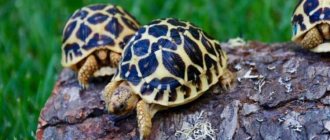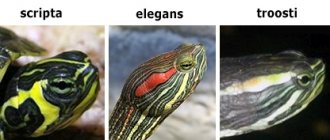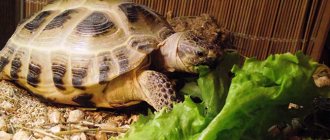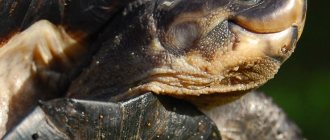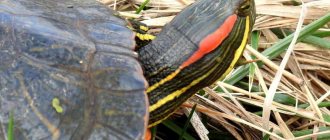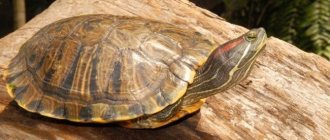TOThey gave me this land turtle at my request when I was 5 years old for 25 rubles. We came to a woman’s apartment; she had two turtles, a female and a male, sitting in a small plastic box. The female was greenish and I didn’t like it, so I decided to get a male
In terms of size, it was basically the same as it is now, or maybe I just didn’t notice the difference in size over these 20 years. As a matter of principle, I do not feed him unnatural food, which is recommended to be fed in books - for example, meat, boiled eggs, etc.
He eats dandelions, apples, cucumbers, loves tomatoes and yellow dandelion flowers. In the summer, I go for walks with him to the quarry and to the river, so that the turtles can take a break from the apartment routine and remember their homeland - nature
The shell of the Central Asian tortoise is low, round, yellowish-brown in color, with vague dark spots; The carapace has 13 horny scutes, the plastron has 16, there are 25 scutes on the sides of the carapace, each of the 13 scutes of the carapace has grooves, usually the number of grooves corresponds to the number of years the turtle has lived (similar to circles on a cut of a tree). The size of the turtle usually does not exceed 20 cm (the record specimen is 28 cm). Females of Central Asian turtles are noticeably larger than males. On the front legs of the Central Asian tortoise there are 4 toes, on the back of the hips there are several small horny tubercles. The Central Asian tortoise is distributed in the southern regions of Kazakhstan, throughout the plains of Central Asia, in North-Eastern Iran, Afghanistan, in the north-western regions of India and Pakistan. It lives in clayey and sandy deserts with thickets of wormwood, tamarisk or saxaul, in the foothills up to altitudes of 1200 m above sea level, in river valleys, and on agricultural lands. Its numbers in many places are very high. Despite this, the Central Asian turtle is listed in the international Red Book
In June 2010, I decided to do a souvenir photo shoot for my beloved turtle, this is what happened
Natural habitat and lifestyle
The family of land turtles includes 16 genera and 57 species.
Habitat: Southern Europe, Central Asia, Kazakhstan, Africa, America, China. Some species inhabit savannas, steppes, deserts, and live in tropical rainforests.
Turtles in nature choose ready-made burrows for their homes; if there is no such housing, they dig them themselves. The soils where reptiles live can be loamy or sandy. Turtles like to settle in high places. For normal life, they need grass and proximity to a body of water.
Features of land turtles and appearance
To understand how to distinguish a land turtle from an aquatic one,
it is necessary to consider the characteristics of land inhabitants:
- The size of individuals varies from 10 to 180 cm. The largest land tortoise is the elephant (or Galapagos) tortoise, more than 1.8 m long.
- The shell of reptiles can be of 2 types: flattened or high. From above, the back of the animal is covered with a strong carapace, the abdomen is hidden in a plastron.
- The shell is so strong that it can support a weight many times greater than the mass of the turtle itself.
- The elephant-like, powerful and short legs have fused toes with free claws.
- The short triangular tail ends in a sharp spike.
- The coloring of turtles does not attract attention. Most often, individuals are brown, olive-gray, or yellowish.
- Leathery scutes and scales cover the tail, head and legs.
- Some species hiss like snakes when threatened.
- If a turtle needs to protect itself, it quickly empties its bladder.
- A leisurely animal does not run away when in danger, but pulls its body inside its shell.
- Females are larger than males.
Land turtles, unlike aquatic ones, have a less bright body color, are more expensive, but are cheaper to maintain, they are easier to care for and clean the terrarium.
The shape and type of shell is associated with the lifestyle of turtles
Look what the largest land turtle looks like???
Care and maintenance of turtles
Some people keep the turtle “free-range”, but this is absolutely wrong, since heat-loving animals suffer greatly from drafts, as well as from various dust and dirt on the floor. It is possible to keep them in a pen, for example, in a kitchen or bathroom, equipped with a warm floor and heating from above - but still, the best for turtles, of course, is a terrarium;
For one turtle you will need a horizontal type terrarium, with a minimum size of 50(length)*40(width)*30(height including space for a lamp); It is best to use small pebbles as soil; If a turtle has a tendency to swallow pebbles, they should be immediately replaced with very large ones. Central Asian turtles are big fans of bathing, be sure to bathe them 2 times a week with clean water +30 +32 C.
You will need a heating lamp, usually an incandescent lamp is enough to illuminate 1/2, 1/3 of the area of the terrarium; The power of the lamp depends on the volume of the terrarium - approximately 4 watts of power will be required per liter of volume. An ultraviolet lamp must also be present, since due to a lack of sunlight, rickets can begin, which, unlike in humans, can begin at any age of the turtle.
The ideal temperature for land turtles is +26 – +30C.
Do not place the food container under a lamp.
A turtle definitely needs shelter. Ideally, one shelter for each individual; An ordinary ceramic flower pot, sawn into two halves so that the turtle can turn around, works well as a shelter. It is recommended to sand the edges so that the turtle does not get cut; or a wooden house, but so that the nails do not stick out!!!
It is also not necessary, but it is advisable, if the size of the terrarium allows, you can place a bowl filled with water there, where the turtle could swim at any time. To do this, you also need a thermal wire (it should be protected with a layer of polystyrene foam, since the scoop can dig out and get burned on hot lead) so that the water is warm. Turtles have a habit of defecating in this bathing vessel, so be prepared to change the water.
Types of land turtles
Among the huge variety of land turtle species, not all can be kept at home. All babies are born small - the body does not exceed 3 cm. During its life, such a turtle can gain weight up to 900 kg.
Individuals whose body size does not exceed 30 cm in length are suitable for home breeding.
Steppe Central Asian
The Central Asian turtle has been bred at home for more than 50 years. By the age of 10, the reptile reaches sexual age, and grows in length up to 30 years. Inhabits the territories of Central Asia, Afghanistan, Iran. Yellowish or brown carapace, slightly convex. The plastron consists of 16 scutes; the carapace includes 25 links in the side part and 13 in the top.
Central Asian tortoise
Mediterranean
Popularly it received other names: Caucasian or Greek. The color of the carapace can be of three colors: yellow, olive, brown. It grows no more than 35 cm in length. The scutes may contain black inclusions. Under natural conditions, it inhabits North Africa, Dagestan, Armenia, Georgia, the Caucasus, and Greece. Good for home keeping.
Mediterranean turtle
Kinixa
Toothed Kinix is the name of Schweger's land turtle. Listed in the Red Book. The carapace is elongated and flattened. Yellow stripes are clearly visible on a brown background. Plastron yellow. Distribution range of the fringed land turtle –
the island of Sardinia and southern Greece.
Jagged Kinix
Star-shaped
This species can be found in India, Sri Lanka, and Pakistan. The dimensions of the shell of a large land turtle are as follows: male - 15 cm, female - 25 cm. The color of the carapace immediately catches the eye - each scute is bordered by a yellow convex pattern in the shape of a star. The star-shaped variety is a decoration for a terrarium. At home it can live up to 80 years.
Stellar turtle
Radiant
Rare species, distribution area - Madagascar Islands. The turtle got its name due to the fact that it has regular yellow lines on its shell, similar to the rays of the sun.
Unlike red-eared turtles, land turtles do not need water - they live on land. They only need liquid for drinking.
Radiant turtle
Pros and cons of home keeping
There are positive and negative aspects to keeping land turtles. Let's start with the advantages:
- unpretentious pets do not require close attention, therefore they are recommended for people with an unpredictable regime;
- for land turtles at home it is easy to recreate conditions close to natural;
- when going on vacation or a long trip, you can take the animal with you in a carrier or in a box;
- you can ask your neighbors to look after the turtle while the owners are away;
- feed is cheap;
- animals are not aggressive;
- clean;
- hypoallergenic;
- do not require constant walking;
- feeding frequency is convenient for owners;
- does not cause damage to the apartment.
In addition, pets can live perfectly alone; they do not need to buy a companion. However, there are also negative aspects when maintaining a house:
- many land turtles are endangered species and are listed in the Red Book, so they cannot be kept at home without the appropriate documents;
- since the pet does not control natural processes, the animal cannot be trained to use a tray;
- the terrarium needs to be cleaned frequently, the whole procedure takes at least an hour;
- after walks, excrement remains on the sofa;
- may bite if hungry or feels discomfort;
- the shell can become a breeding ground for fungal microorganisms, so you must wash your hands after contact with the turtle.
It is not of particular interest to children, as it does not support active games. Some species have a completely restless character.
Watching a turtle can bring a lot of joy
Keeping a land turtle at home
The land turtle requires minimal care. Once every 7 days she should be bathed in warm water, the temperature of which does not exceed +30°C. You should not pour a lot of water into the basin; the level should be equal to half the shell. When animals begin to shed, it is recommended to add 1 tsp during washing. soda Long claws are shortened with a manicure file.
Rule 1. Spacious terrarium
After purchase, the land turtle must be placed in a box - a temporary home until the terrarium is ready. You cannot leave your pet on the floor, as temperature changes are contraindicated for him. It is better if a 100 liter tank is chosen for the turtle. Ideally, the parameters of the terrarium should exceed the length of the animal by 3 times. You definitely need a house in the container so that the reptile can rest peacefully from the gaze of household members.
Rule 2. Soil without small particles
The bottom of the terrarium must be lined with soil 10 cm thick. Medium-sized pebbles can be used as a covering, since the turtle can swallow small pebbles. Some people use scented sawdust. However, this coating has one drawback - they quickly become dirty.
The most ideal option would be a mixture of hay and pebbles. You should not put cat litter, sand, or garden soil on the bottom of the terrarium. The fact is that a turtle can eat such soil, which will lead to deterioration in health.
Caring for a land turtle at home begins with arranging the home
Rule 3. House for privacy
Inside the main tank you need to install a house (possibly wooden). It is necessary so that the turtle can hide from the rays of the sun and have privacy.
Rule 4. Edible plants
You can decorate the terrarium with potted indoor flowers: climbing plants, aloe, sansevieria. It is best to transplant the flowers into a small pot and place them in a tank. The soil in the container must be covered with stones. You should not decorate with poisonous plants, as the turtle may taste the leaf.
To decorate your terrarium, choose non-hazardous plants.
Rule 5. Temperature as in nature
In the terrarium, it is desirable to create the same living conditions for turtles as they are accustomed to in the wild. Since reptiles are heat-loving animals, the air temperature should not fall below +25°C.
Rule 6. Heating as part of the temperature regime
You can maintain optimal mode using a 75 W incandescent lamp. It should be placed at a height of 40 cm from the bottom of the terrarium.
Rule 7: Lighting to supply vitamin D
In addition to the incandescent lamp, it is necessary to install an ultraviolet lamp at the same level. It will supply your pet with vitamin D3, which is necessary for the absorption of calcium.
The desired temperature in the terrarium is achieved using a heating lamp
Rule 8. Proper feeding
To keep the turtle healthy, feeding should be done at the same time, preferably in the morning. After a while, the pet will get used to this regime and will expect the next treat. Turtle breeders recommend following the following rules when feeding:
- Babies need to be fed daily, adults – once every 2 days.
- The food container must always be clean.
- Feed small amounts, although the turtle will not eat more than it should.
- After finishing the meal, the saucer with the remaining food must be removed from the tank.
- Strong irritating noise and strong odors negatively affect the functioning of the digestive system.
- You cannot feed the animal by hand.
It is recommended to exclude harmful foods from your pet’s diet:
- garlic;
- insects;
- milk;
- spinach leaves;
- spicy herbs;
- food from the table;
- leaves of poisonous plants.
Attention!
The turtle should not be fed in the evening, as at this time the pet is preparing for bed. She will not be able to digest food, since her activity is zero. You can feed in the morning or afternoon, at this time the digestive tract works well. No leftover food should be left behind.
The basis of the diet of a land turtle is plant food.
If a turtle tramples on its food, it considers it no longer edible - spoiled. A pet may refuse a favorite treat for several reasons:
- overfeeding;
- no fasting days;
- abuse of treats.
Taking into account the size of the reptile, it is necessary to calculate a single portion. The amount of food per day should be equal to half the length of the shell, and a piece of food equal to half the turtle’s head.
Do not feed foods that have undergone heat treatment. All food should be raw but warm. The diet should not be the same. Only variety will allow the reptile to get all the nutrients.
Turtles love bright colors. To ensure that food is completely absorbed, it is recommended to give yellow, red, orange foods.
Feeding for land turtles should vary depending on the season. In summer, you should include more plant food in your diet. Turtles need to be fed:
- dandelion leaves;
- cucumbers;
- clover;
- berries;
- pumpkin;
- zucchini;
- mushrooms;
- sorrel.
In winter, common vegetables are: beets, cabbage, carrots. Fruits are necessary for reptiles to saturate the body with vitamins.
From time to time, crushed shells should be on the menu. Bone meal can be given to meet calcium requirements. Juicy greens saturate the body with moisture, which prevents dehydration.
Diet diversity improves health and increases life expectancy
Rule 9. Vitamins for prevention
To strengthen the shell, it is necessary to give calcium powder. Alfalfa meal will provide your pet with additional beneficial substances.
Pharmacy vitamins can only be purchased after consultation with a veterinarian. Medicines for humans are not suitable for treating turtles - they are toxic to pets.
Rule 10. Be sure to drink if the food is not juicy enough
If land turtles have enough succulent food, they do not need additional liquid. Therefore, the diet should include vegetables: cabbage, cucumbers, greens, lettuce. The products not only saturate the animal, but also satisfy its need for fluid. In summer, you should include clover and dandelions in your diet.
Reptiles especially need to drink when dehydrated, which occurs as a result of insufficient feeding of juicy vegetables. You can install a saucer or drinking bowl at the bottom of the terrarium. The water should always be warm, so the saucer should be placed under the lamp. The reptile often turns over the drinking bowl, so you need to constantly update its contents.
Attention!
Turtles often like to defecate in the water. Therefore, the owner must constantly monitor the cleanliness of the liquid. If your pet drinks contaminated water, it can become seriously ill.
A complex of vitamins and minerals can be purchased at pet stores
Rule 11. Mandatory walks
Walking down the street with a turtle is allowed if the air temperature remains at +25°C for several days. If the reptile gets hot, it will try to hide in the shade. To prevent your pet from getting lost or being attacked by dogs and children, you need to constantly monitor the tiny creature.
A turtle can walk on the sofa in the house, but not on the floor.
Rule 12. Regular bathing and hygiene
Many people do not know how to properly bathe a land turtle, so they are afraid to carry out this procedure. There is nothing new about how to wash your pet. Bathing should take place every week. Warm water should be poured into the basin in such a volume that it covers the turtle’s shell just above half. The water temperature for swimming should be +25°C.
Walking in the summer is a must
What to feed turtles
Turtles are fed every day, preferably at the same time;
The main food for turtles is vegetable,
Foods that are strictly harmful to turtles
- Poisonous plants: nightshade, buttercup, medicinal plants containing alkaloids, dieffenbachia (Diffenbachia spp.), euphorbia (Euphorbia spp.), azalea (Azalia spp.), elodea, lagenandra, ambulia (limnophila), oleander, narcissus, spurge, crocus , cyclamen, delphinium, foxglove, hydrangea, jasmine, lilies, lobelia, lupine, mistletoe, potato leaves, rhododendron...
- Citrus peels, fruit and berry seeds.
- Eggshells, ground egg shells (can cause salmonellosis).
- Canned and dry food for domestic warm-blooded animals and fish.
- Human food: porridge, cheese, any bread, rolls, dumplings, milk, cottage cheese, boiled or fried food, raw and boiled eggs.
- Animal food for Central Asian land turtles and most land species: meat, fish, insects.
If land turtles, whose digestive tract is configured for slowly digesting food, are fed protein foods for a long time, then uric acid, formed during the breakdown of proteins, cannot be released in sufficient quantities, as a result, the kidneys do not work well. Meat contains more than just protein, and turtles do not have the ability to break down and remove such substances from the body. Food that is harmful to turtles in large quantities - Plants containing high amounts of oxalates (which interfere with the absorption of calcium in the intestines and can lead to the development of false gout): spinach, bean sprouts, rhubarb.
- Growogenic plants (cause iodine deficiency and goiter): various varieties of cabbage, radishes, turnips, radishes, mustard and wild cruciferous vegetables.
- Tomatoes and other foods rich in phosphorus interfere with the absorption of calcium.
- Foods rich in purines or potentially alkaline (may contribute to the development of true gout): asparagus, cauliflower, spinach, cereal grains, mustard, mushrooms, pineapples, as well as raw liver, kidneys and fatty fish.
- The following fruits, herbs and vegetables: potatoes, celery, lettuce, onions, garlic, cruciferous vegetables, rhubarb, herbs (thyme, basil), pear, many sweet fruits, cherries.
- Dry food for reptiles and turtles. Turtles do not need them and have a bad effect on the body.
- a lot of sorrel (due to the acid it contains);
- a lot of cucumbers (very swelling);
- herbs (thyme, basil)
Add vegetable protein to the food - these are soaked and sprouted beans, alfalfa is a good source of protein, but do not overuse it.
Buying food from pet stores is harmful to turtles. You can buy vitamin supplements at a pet store, but with special attention.
Central Asian turtles must be given calcium supplements at the rate of 100 mg of “pure” calcium per 1 kg of turtle weight. Give no more than once a week. Glycerophosphate, carbonate, borogluconate, and calcium palmitate are not suitable because they are poorly absorbed by the body and are eliminated from it almost completely. It is best to give “natural” food - freshly picked plants.
During the fall and winter season, you can feed turtles hay, but you must also give them plenty of water. All turtles love sweet fruits, but it is strictly forbidden to give them in large quantities - this leads to obesity.
Wintering and hibernation
Turtles usually spend 8-10 weeks (babies) and 12-14 weeks (adults) in hibernation. If you put it to sleep artificially, you need to calculate the time to wake the turtle from hibernation in February. At this time, the length of daylight hours increases.
The condition of reptiles should be checked every month. It is acceptable if the weight of individuals decreases by 1%. If turtles lose weight quickly, it means they are sick and hibernation must be stopped. You cannot swim during winter.
How to properly put a turtle to sleep:
- You need to make sure that the reptile is healthy. It is not recommended to give vitamins before wintering.
- Immediately before hibernation, it is important to fatten the pet so that it has enough fat reserves for the wintering period. The pet needs to drink.
- The turtle should be bought in warm water, wiped dry and not fed for 1 week (kids), 2-3 weeks (adults). This time is necessary so that all the food eaten by the reptile can be digested.
- Now you need to gradually reduce the temperature and daylight hours.
- For wintering, you need to prepare a special tray, on the bottom of which lay wet sand, peat, and place sphagnum moss. The thickness of the layer should be 20-30 cm. The turtle is placed on this layer and covered with hay or dry leaves. The substrate should be moist, but not wet.
- In this form, the container with holes made in it should spend 2 days at room temperature, then it should be moved to the corridor and placed on the tile.
- You need to know how to wake up a turtle in order to bring it out of hibernation without harming it. All manipulations must be carried out in reverse order. A warm bath will help bring your pet out of his stupor.
If everything is fine with the turtle, it will begin to eat after 5 days, once the optimal temperature has been established.
Preparing for hibernation, the turtle tries to burrow into the ground
Features of the Cherehapa aggregator
Let me explain a little what I mean by “features”: aggregators have certain lags that are not very logical. They are neither bad nor good. They just need to be taken into account. I counted 7 of these at Cherekhapa.
Price range
I'll start with a simple example. Policy Consent insurance for 14 days in Thailand:
- On Cherehapa.ru the cost is 1443 rubles with assistance from AP Companies. Look.
- On the official website the cost is 2021 rubles with Best Service assistance.
- On Polis812 the cost is 1356 rubles with Balt assistance. Look.
- On Sravni.ru the cost is 1613 rubles with assistance from Savitar Group. Look.
This is a disease of all sites, but I remind you once again: no matter how good the aggregator may seem, spend 10 minutes searching for the best price. By the way, the cost also depends on the assistance that comes in conjunction with the insurance company. The following feature follows from this.
Lots of assistance
More choice is always good, but only if there is no confusion. In 2021, Cherekhapa insurance works with the following insurance companies and assistance:
- Allianz – Mondial (Allianz Global Assistance);
- SBERBANK INSURANCE – Europ Assistance;
- Consent – Best Service, AP Companies;
- Absolute Insurance – Savitar Group;
- Zetta Insurance – AP Companies;
- Liberty – Class Assistance;
- AlfaStrakhovanie – Best Service, Class Assistance;
- ARSENAL – Balt Assistance;
- VSK – MedAssist International;
- VTB Insurance – Global Voyager Assistance;
- Ingosstrakh – Asiser Assistance, Balt Assistance, Remed Assistance;
- Renaissance – Class Assistance, First Assistance;
- Russian Standard – AP Companies.
The selection of assistance companies is impressive.
Insurance zones
Insurance companies do not insure specific countries, they cover zones. Let's say you bought insurance on Turtle for a trip to Germany. One country will be indicated on the website, and Schengen will already be in the policy. Most insurance zones have only 3 and they differ in cost: the most expensive is Asia, then the USA and the cheapest is Europe. This is a standard scheme for all insurance companies and aggregators, which you can make work for yourself.
The list of insurance companies depends on the currency
When choosing insurance for traveling abroad on Turtle, put dollars first, then euros (or vice versa). For example, Sberbank Insurance only insures in euros, so you will not see it in the list, since the default search criteria is dollars.
Cherekhapa automatically extends insurance for Schengen
For the Schengen zone, special requirements apply: the policy must not have a deductible and its validity must be 2 weeks longer than the trip itself. When selecting the Schengen zone, Cherekhapa does this automatically.
Arrows in comparisons of conditions
As I said, Cherehapa is a convenient place to compare travel insurance conditions abroad. But there is one nuance: the aggregator sometimes shows up or down arrows opposite the options. For example, here I have chosen a coverage amount of 50,000 euros, and Sberbank shows an up arrow. We hover the cursor and see that this insurance company insures not for 50, but for 60 thousand.
Opposite the option “insurance for pregnancy complications up to 24 weeks” we see a down arrow. This means that the same Sberbank is ready to insure only up to the 12th week.
Hidden field for entering a promotional code
Turtle insurance, in principle, does not please travelers with discounts. Perhaps the aggregator decided to stand out from the desperately dumping companies. Well, it’s a business matter, but the fact that there is a field for entering promotional codes is already encouraging. All that remains is to find him. I'll show you how.
Compatibility
Turtles do not need neighbors, they do not suffer from loneliness. If you really want to get yourself several turtles, then Mediterranean and Central Asian turtles support cohabitation. Forest, steppe and desert will be at enmity. Representatives of other species should not be placed with pets, as they can be carriers of various diseases.
Frogs, snakes, toads, crocodiles, lizards, snails, and newts should not be kept together with reptiles. Turtles are not compatible with chameleons and mollusks. The fact is that all animals have different requirements for humidity and temperature. Each species requires a specific type of terrarium and soil.
Reproduction of land turtles
Turtles become sexually mature at 6 years of age. Before mating, it is recommended to make sure that the pets are not sick. The main conditions for good development: hibernation, balanced nutrition, warmth.
Females should be larger than males. Boys need to be placed next to girls, not the other way around. There may be more females. It’s good if the gentlemen start fighting for the right to please the ladies. However, everything that happens must be monitored so that the males do not injure each other.
Once pregnant, the turtle becomes restless, loses its appetite, and begins to fence off space. A pregnant female should be fed different types of food so that she can make a choice. You should definitely add calcium to your food.
Attention!
Pregnancy lasts 60 days; this period can be artificially extended if the female has not had time to prepare a place for laying.
How to determine the sex of a land turtle
How to find out the gender of land turtles? Females and males have visible differences. Females are significantly larger in size than males. When the males turn over, you can see a small depression on the shell - a concavity in the shell, which is what is necessary for mating. The tail of females is large, thick, and the cloaca is located at the base of the tail.
Caring for the Cubs
After the babies hatch, they can still remain in the egg for 3 days. They are born 3 cm long. If the turtles cannot get out after 3 days due to lack of strength, the owner must intervene and get the babies. If you are lucky enough to have twins born, you must be extremely careful with them, since the cubs are weaker than usual. Next, they should tie the umbilical cord with a thread, they will do the rest themselves.
Babies are kept separately! Housing conditions are similar to adult animals, only they should be fed soft food and irradiated with a 10% UVB lamp. Under good conditions, a turtle will live with its owner for at least 40 years.
Gender determination is possible from the age of 1.5-2 years
Reviews about the Cherekhapa aggregator
I'll start with the review that caused the most confusion in the work of the service. This was actively discussed on the forums.
The situation is as follows: a girl bought insurance for her child on Turtle for a trip to Thailand from Rosgosstrakh. The website contained a list of assistance companies with which the insurance company works with the note: assistance is assigned upon the occurrence of an insured event.
There were 5 companies on the list, including the notorious GVA. Among other things, the website indicated that upon request, the assistance service will contact the victim and the call will be free. Having paid for the policy, the girl at first did not notice that assistance had already been scheduled. It turned out to be GVA.
An insured event has occurred. The girl called and they charged 1,000 rubles. I also had to pay for an incoming call from the assistance service to a local SIM card. With great grief, the girl was sent to Bangkok Hospital (one of the most expensive, by the way!). It would seem that everything is fine, but it was not so: it turned out that GVA does not work with Bangkok Hospital. She had to pay for everything herself, and upon returning home, arm herself with checks and storm Rosgosstrakh. The situation is unpleasant, considering how much medicine costs in Thailand. But the most interesting thing began after the girl posted a detailed review on Otzovik, more than once remembering the Turtle with an unkind word.
A representative of the company came in the comments and said that the client cannot choose assistance and, to prove his words, cited a list of five assistance services from Rosgosstrakh, emphasizing that everything is honest on Turtle’s part. You saw this in the previous screen. Then there was an explanation that if the case was recognized as insured, then the girl would be reimbursed for everything (spoiler: the case was NOT recognized as insured).
And then everything smoothly flowed into the stage, on which it was time to stage the play. H – Turtle, D – girl.
Ch: – What did you expect if it is written that assistance is assigned (gives a list)?
D: – I didn’t expect GVA specifically! It is immediately registered in the policy (referring to the photo of the policy attached to the review).
C: - Well, you might have come across GVA.
D: – Where is the logic? Why do I see a specific assistance only after payment? What is this, a lottery?
C: – In ANY case, you would have come across GVA, but on the website it is written that assistance is assigned. Our opinions completely coincided. Now insurance from Rosgosstrakh is a lottery, since the assist is assigned by the insurance company. The rest are fine.
D: ...
I was unpleasantly surprised by the boorish behavior of Cherekhapa’s representative, who repeatedly ignored the victim’s request to respond by email rather than in public comments to the review. However, only thanks to him, I and thousands of users learned about this situation.
To be honest, such illogical behavior is beyond my comprehension. The correspondence is so ridiculous that if I saw it on some website, I would think it was a fake. Therefore, I am attaching a link to the entire review. Read and see for yourself. All correspondence is below in the comments.
I sincerely hope that Turtle Insurance has changed the attitude towards those traveling abroad, since the review is still more than a year old.
Cherehapa handled this negative review beautifully. The victim accused the company of not refunding insurance costs. I wrote and called, they promised to return the money, but for a whole month and a half there was silence. Not good…
But then a company representative came and put everything in its place




